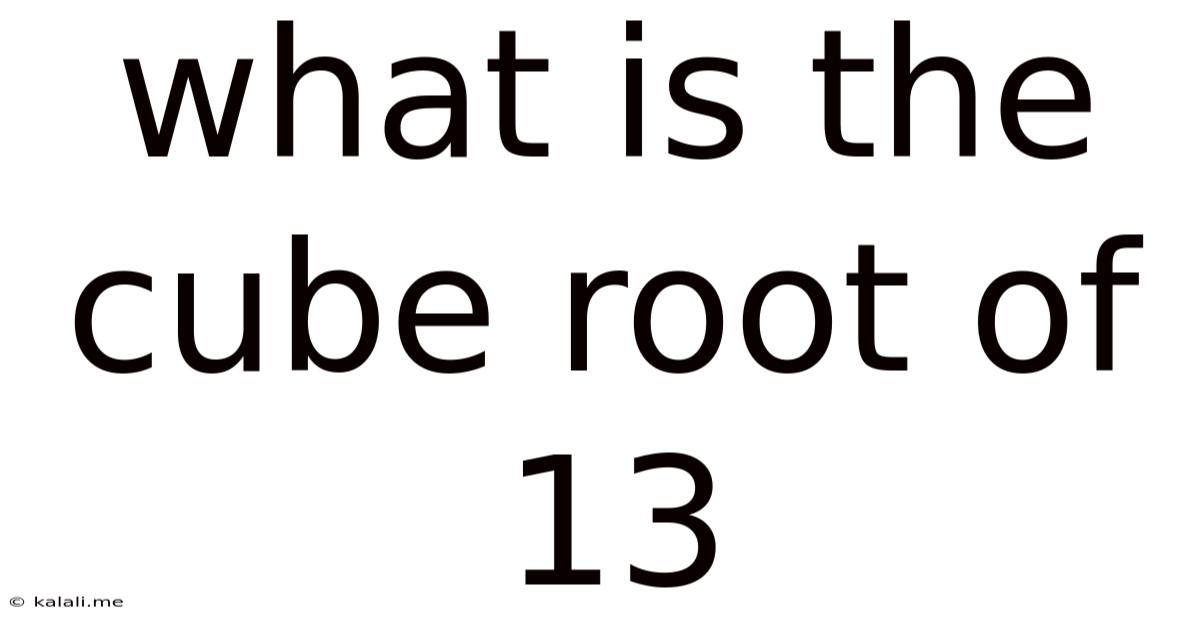What Is The Cube Root Of 13
Kalali
Jun 13, 2025 · 3 min read

Table of Contents
What is the Cube Root of 13? A Deep Dive into Calculation and Applications
Finding the cube root of 13 might seem like a simple mathematical problem, but it opens doors to understanding several important concepts in algebra and numerical analysis. This article will explore how to calculate the cube root of 13 using various methods, and discuss its applications in different fields. Understanding the cube root of 13 is key to mastering fundamental mathematical operations.
The cube root of a number is a value that, when multiplied by itself three times, results in the original number. In simpler terms, if x³ = 13, then x is the cube root of 13. Unlike perfect cubes like 8 (2³) or 27 (3³), 13 doesn't have a whole number cube root. This means we need to employ approximation methods.
Methods for Calculating the Cube Root of 13
Several methods can help us approximate the cube root of 13:
1. Using a Calculator: The easiest way is to use a scientific calculator. Most calculators have a cube root function (often denoted as ³√ or x^(1/3)). Simply input 13 and use this function. The result will be approximately 2.3513.
2. Numerical Methods: For a deeper understanding, let's explore numerical methods. One common method is the Newton-Raphson method, an iterative process that refines an initial guess to approach the actual root. While computationally intensive without software, it demonstrates the underlying principles of numerical analysis.
3. Linear Interpolation: A simpler approximation can be achieved through linear interpolation. Since 2³ = 8 and 3³ = 27, we know the cube root of 13 lies between 2 and 3. We can estimate the value proportionally:
- The difference between 27 and 8 is 19.
- The difference between 13 and 8 is 5.
- Therefore, the cube root of 13 is approximately 2 + (5/19) ≈ 2.26 (This is a rough estimate).
4. Using Logarithms: Logarithms provide another approach. The cube root of 13 can be expressed as 13^(1/3). Using logarithm properties:
log(13^(1/3)) = (1/3)log(13)
By finding the logarithm of 13, dividing by 3, and then finding the antilogarithm, we can arrive at an approximation. This method requires a logarithm table or calculator with logarithm functions.
Applications of Cube Roots
While seemingly abstract, cube roots have practical applications in various fields:
-
Engineering and Physics: Cube roots are crucial in calculations involving volume, such as determining the side length of a cube given its volume. Applications extend to fluid dynamics, material science, and more.
-
Geometry: Calculating the dimensions of three-dimensional objects often requires cube roots.
-
Data Analysis: Cube roots can be used in statistical analysis, particularly when dealing with data involving cubic relationships.
-
Finance: Compound interest calculations sometimes involve cube roots in determining investment growth rates.
Conclusion
The cube root of 13, approximately 2.3513, is not a whole number, highlighting the need for approximation methods. Understanding these methods—whether using a calculator, numerical techniques, interpolation, or logarithms—provides valuable insight into fundamental mathematical concepts. Furthermore, the seemingly simple calculation of the cube root of 13 underlines its significant role in numerous practical applications across diverse scientific and engineering disciplines. Mastering this concept is a crucial step in developing a solid mathematical foundation.
Latest Posts
Latest Posts
-
Mi Familia Fuera La M S Grande Correct Incorrect
Jul 01, 2025
-
How Much Is 20 Pounds Of Pennies Worth
Jul 01, 2025
-
How Much Does A Gallon Oil Weigh
Jul 01, 2025
-
How Many Crackers In A Sleeve Of Saltines
Jul 01, 2025
-
How Many Years Are In 48 Months
Jul 01, 2025
Related Post
Thank you for visiting our website which covers about What Is The Cube Root Of 13 . We hope the information provided has been useful to you. Feel free to contact us if you have any questions or need further assistance. See you next time and don't miss to bookmark.